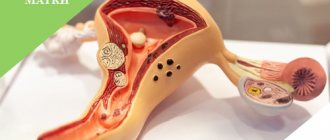According to modern data, infertility or lack of conception within 1.5 years of unprotected sexual activity is observed in 15% of married couples.
Treatment of male infertility at the Ostmed clinic: help from an osteopathic doctor
The family examination begins with a spermogram of the husband. If its deviations are pronounced, the man is treated first. This is where osteopathic treatment can help.
A common cause of male infertility is varicocele (varicose veins of the testicle). Surgical treatment of this disease is ineffective or has a short-term effect, since its main cause is spasm of the pelvic and abdominal diaphragm, which osteopaths can treat.
Chronic prostatitis , as the second important reason for changes in spermogram, is associated with impaired microcirculation of the pelvis, changes in the lumbosacral spine to a greater extent than with infectious processes. And here osteopathic help is indispensable.
The most complex problems in the delicate area of men's health can now be solved especially quickly and effectively.
Female infertility: causes and treatment methods at the Ostmed clinic
Only if the man has no problems does a long, complex examination of the woman begin. And here it is necessary to highlight the following possible causes of infertility:
- Hormonal . The system regulating the menstrual cycle includes the central nervous system, the ancient brain (hypothalamus, pituitary gland), ovaries and adrenal glands (a very small organ located at the top of the kidney and responsible for the body's response to stress). A disturbance in each of the structures can lead to a lack of production of an egg necessary for the fertilization process. In the absence of pronounced, sometimes genetically determined, disruptions in the regulation of the menstrual cycle, the help of an osteopathic doctor can be very effective. Soft cranial techniques allow you to relieve tension from the central nervous system, improve blood supply to the brain, restore the function of the pituitary gland and, thereby, normalize hormonal balance. In turn, osteopathic work with the patient’s pelvis makes it possible to return the normal location of the ovaries, changes the microcirculation of blood in their tissue, stabilizing the hormonal balance from bottom to top
.
- Adhesive process or pelvic, tubal factor.
One of the problems of female infertility is obstruction of the fallopian tubes. They can be “sealed inside” due to inflammatory processes and abortions, as well as “outside”, which is a consequence of an inflammatory process more typical of the intestines, appendicitis and pelvic inflammation of unknown etiology. In turn, the appearance of adhesions can create (for example, with x-rays of the uterus and tubes) a twisted pelvis, when in the absence of adhesions and indications of inflammatory processes, the impression of a pronounced change in the anatomy of the pelvis is created. Here the help of an osteopathic doctor is irreplaceable. Normalizing the position of the coccyx, working on the uterine ligaments, and soft techniques for working with the adhesive process can improve the patency of the fallopian tubes.
- Uterine factors or synechiae (intrauterine factors) after abortion and rough uterine curettage. They are quite rare. Osteopathic care is possible after surgical dissection of synechiae, as a prevention of their re-formation.
- Unexplained causes of infertility . Often they are based on spasm of the cervix at the time of sexual intercourse and a tendency to spasm of the fallopian tubes, which does not allow sperm to penetrate into the uterus and fertilized eggs from the tubes into its cavity. Here osteopathic techniques are very effective. Techniques for working with the sacrum and removing clamps from the pelvic diaphragm allow a long-awaited pregnancy to occur.
- Psycho-emotional problems . In many cases, the reasons for the absence of children may be fear of pregnancy and childbirth, excessive responsibility in making the decision to become parents, or tense anticipation of a planned child. The chronic stress associated with this can be relieved using osteopathic techniques.
Make an appointment with doctors with extensive experience in this field:
Razdobreev Alexander Semenovich
Candidate of Medical Sciences.
Member of the Russian Osteopathic Association.
Leading specialist of the clinic.
Member of the Board of Trustees of the Foundation for the Promotion of Osteopathy in Russia.
Member of the medical expert council.
Cost of admission: 10,000 8,000 rubles
More about the doctor
Ploshnitsa Maria Alekseevna
Osteopathic doctor, neurologist, kinesiologist.
Leading specialist of the clinic.
Member of the Russian Osteopathic Association.
Cost of appointment: 10,000 8,000 rubles (50% discount in the Program of the Foundation for the Promotion of Osteopathy Development)
More about the doctor
Sergeeva Liliya Alexandrovna
Osteopathic doctor, obstetrician-gynecologist, neurologist, reflexologist.
Leading specialist of the clinic.
Member of the Russian Osteopathic Association.
Admission fee: 5,000 rubles
More about the doctor
What is osteopathy?
For many years, osteopathy was classified as “alternative” medicine. Today it has deservedly taken its place among the officially recognized and sought-after medical areas.
Osteopathic medicine originated in the United States more than 140 years ago. For the first time, Andrew Taylor Still used and described methods of treating diseases with his hands. The famous doctor had excellent knowledge of human physiology and anatomy. When creating a medical doctrine based on the laws of nature, he formulated the basic principles of osteopathy, which are still relevant:
- Each organ has its own function. If all the elements are intact and the connections between them are established, the body works smoothly. If at least one structure is damaged, the functions of all organs suffer.
- The human body is a single system. If diseases are treated without eliminating the causes, over time they become chronic and often recur. An individual organ cannot suffer on its own; the whole body participates in this process.
- Any organism is capable of self-correction and self-regulation. It adapts perfectly to all internal and external changes, while the physical and mental states of a person are interconnected. Finding itself in unfavorable conditions, the body begins to react to them, which leads to the appearance of areas susceptible to degeneration or hypertrophy, and infection. This is how disorders arise for which a person needs urgent treatment. If you find an imbalance, find out its nature and cause, the body will cope with the problems on its own. This ability to self-heal is inherent from birth, and an osteopath only helps to activate internal self-healing mechanisms.
To return the body to a harmonious state, an osteopathic doctor does not need auxiliary means. He uses only his own knowledge and hands, works without pills, injections or additional tools.
What does an osteopath treat in adults and children?
The list of diseases and conditions for which patients can contact an osteopathic specialist is quite wide and varied:
- ENT diseases: sinusitis, chronic otitis, sinusitis, tonsillitis.
- Spinal diseases: osteochondrosis, intervertebral hernia, scoliosis, spondylosis, spondyloarthrosis.
- Neurological pathologies: intercostal neuralgia, pathological intracranial pressure, tension headaches, migraines.
- Diseases of the respiratory system: bronchitis, pneumonia, bronchial asthma.
- Pathologies of the gastrointestinal tract: stomach ulcers, gastritis, diseases of the liver, gall bladder, pancreas.
- Diseases of the genitourinary system: infertility, pain and menstrual irregularities in women, prostatitis and impotence in men.
- Consequences of injuries and operations: adhesions after operations, traumatic brain injuries, contractures and other damage to the musculoskeletal system.
During pregnancy, osteopathic correction can be used to improve the general condition of a woman. Osteopathy sessions can relieve back pain, reduce the severity of toxicosis and swelling, and prevent or eliminate uterine hypertonicity.
Osteopathy is also used to prepare a woman for childbirth, provoking the mobility of the pelvic bones. This makes labor easier and prevents possible injuries to the newborn.
Children's direction in osteopathy is the most important of all others.
Specialists can identify and correct in infancy what can no longer be treated at an older age and has a negative impact on the overall development of the child. For example, the consequences of rapid childbirth or birth injuries.
The knowledge and skills of a pediatric osteopath will be necessary for a child or teenager if he has cerebral palsy, torticollis, flat feet, encephalopathy, hydrocephalus, developmental delay, frequent colds, diseases of the digestive organs and much more.
Types of osteopathy
Initially, osteopathic methods were used to solve problems of the musculoskeletal system, but the treatment and diagnostic system successfully developed, and over time new directions appeared in it. Currently, there are 3 types of osteopathy:
- structural – involves working with the musculoskeletal system;
- visceral – dedicated to restoring the functions of internal organs;
- craniosacral - responsible for the proper functioning of the brain and normal connections between the bone structures of the skull, spine and pelvis.
New areas of modern osteopathy that are still in the process of development include posturology (restoring bodily balance), body-emotional therapy (getting rid of stress and psycho-emotional tension) and biodynamics (restoring cellular potential).
Contraindications to osteopathic treatment
Do not think that osteopathy is a panacea for all health problems. Just like other types of medical procedures, it has contraindications.
- Open bleeding.
- Severe osteoporosis and other bone diseases.
- Malignant neoplasms.
- Heart attacks, strokes, hypertension and other acute pathologies.
- Blood diseases.
- Intestinal infections.
- Mental disorders.
Before starting treatment with an osteopath, it is necessary to inform him of the presence of any chronic diseases in the patient.
How does an appointment with an osteopath work?
When you first visit this specialist, take with you the results of previous examinations: laboratory tests, ultrasound, x-rays, etc.
Working with a patient, an osteopathic doctor uses any levels and techniques available to him to influence the human body:
- Articulation and mobilization methods help relieve muscle tension. The doctor uses soft rhythmic movements without force on the joints. As a result, the problematic structures return to their natural state.
- Muscle-energetic techniques are similar to those used by chiropractors. By combining periods of tension and relaxation, the osteopath works on the muscles surrounding the diseased joint.
- Musculofascial techniques allow you to eliminate excessive tissue tension and restore normal functioning of organs.
- Biodynamic fluid methods involve interaction with fluids that connect all body systems. This is not a massage, but a light, painless manual pressure on certain points to normalize blood flow and lymph movement.
When treating, a specialist always looks for the cause of the disease and at the same time eliminates its symptoms. Sometimes patients feel as if nothing happens during the procedure. This is wrong. Professional osteopathic doctors have their own proven techniques for painlessly influencing muscle chains and trigger points, the stimulation of which triggers recovery processes.
After osteopathic sessions, doctors advise to refrain from serious physical and emotional stress. For 2-3 days after an appointment with an osteopath, it is advisable not to visit the pool, sauna or fitness club, and to refuse massage and other procedures that involve impact on the body.
Get specialist advice or make an appointment
+7 (495) 320-43-41
Impaired blood supply to the pelvic organs
You may have heard this diagnosis - “blood stagnation in the pelvis.” What does it mean? Due to the fact that we lead a sedentary lifestyle and move little, a “swampy area” is formed in the pelvic area - a space from which venous blood flows poorly. This means that not enough arterial blood, rich in oxygen and nutrients, comes here. And the wise organism comes to a completely logical conclusion: even if its own tissues are starving here, then the unborn baby will suffer even more so. Why start a pregnancy process that is doomed to failure from the start?
And this disorder is one of the easiest to treat: there are cases when, within 1-2 sessions, the blood supply to the pelvic organs can be improved, and within a month the patient returns with a long-awaited pregnancy. This miracle of conception has a completely understandable scientific basis: the doctor relaxes the usual tensions, the stomach begins to breathe, the ovaries and uterus literally come to life - and nature takes its toll! After all, where there is movement, there is life, including new and long-awaited life.
Fallopian tube obstruction - did you know that a woman can feign this disease? Of course, not consciously, but quite realistically! Usually this simulation is discovered by a surgeon during an operation: a woman is diagnosed with “obstruction of the fallopian tubes,” she undergoes surgery for some other indication, and in the process the doctor is surprised to discover that the tubes are fine! Why was obstruction diagnosed? The first answer (self-explanatory): an error in the research. And the second one is a spasm! Yes, habitual tension in the pelvic area can lead to spasm of the fallopian tubes, and on an X-ray with contrast they will appear obstructed. Therefore, I recommend that ladies who have been given such a diagnosis, as they say, out of nowhere (that is, before it was diagnosed, there were no serious inflammatory diseases or abdominal surgery), try to undergo osteopathic treatment or - an even more pleasant recommendation! - relax. As it should be, from the heart! Changing your usual routine so that you can periodically change the environment and type of activity is the basic principle of quality, restorative rest. Perhaps, against the background of natural relaxation and harmonization of all processes, in six months the diagnosis will be corrected.
How to make an appointment with an osteopath at the Central Clinical Hospital of the Russian Academy of Sciences?
Experienced osteopaths recommend not waiting for the disease to manifest itself and lead you to the hospital. Regular preventive sessions will help keep the body in normal shape. Certified doctors from the Central Clinical Hospital of the Russian Academy of Sciences offer osteopathic treatment for adults. Our specialists painlessly and effectively treat a variety of diseases without surgery or medications.
You can make an appointment with an osteopath and find out the cost of services by phone or using a special form on the website.
Manual therapy and osteopathy - what is the difference
The definition of “osteopathy” often includes manual therapy. Yes, they almost always accompany and complement each other, but, nevertheless, there is a difference between them.
Manual therapy is a combination of the effects of the doctor’s hands on the musculoskeletal system. Osteopathy has a broader focus on treatment, which includes influencing various organs, managing human health as a whole, and bringing the body to the “right wave”.
The tasks of manual therapy include relieving the symptoms of the disease, i.e. pain relief. Osteopathy is designed to find and treat the root of pain - the disease itself.
With the help of osteopathy, the entire body is diagnosed, which contributes to the effectiveness of treatment.
A distinctive feature of osteopathic treatment in comparison with manual therapy is its relative painlessness.
This allows osteopathic treatment to be used for all age categories of patients, from children to older adults.
The ability of osteopathy to reduce relapses of the disease to a minimum is also its advantage over manual therapy.
It should be noted that there is some connection between these two methods, since osteopathy relies in its knowledge on many years of research and practice of chiropractors.
For an osteopathic doctor to be fluent in his profession, he must also be an excellent chiropractor.
The use of osteopathy for spinal hernia
When treating osteochondrosis, protrusions or herniated intervertebral discs, the osteopath must find out and eliminate the root cause of the disease. These may be congenital abnormalities of the spine, incorrect posture or persistent curvature, trauma or the consequences of operations that affected the pathological displacement of the intervertebral discs.
A specialist can determine the cause of the hernia and eliminate it by relaxing the muscles, restoring the correct statics and dynamics of the spine and pelvic bones.
Simply put, if you eliminate vertebral subluxations and pelvic torsion, remove muscle spasms, then blood circulation is restored and tissue nutrition improves. Thus, conditions are created for the disappearance of the intervertebral hernia.
The pathologically altered disc partially normalizes its shape and position, while the pressure on the nerve roots is reduced and excruciating pain is relieved. Sometimes this allows you to avoid surgical treatment.




